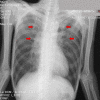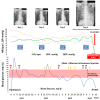A Fatal Case of Takotsubo Cardiomyopathy Secondary to Refractory Hypoglycemia in Severe Starvation: An Autopsy Case Report
- PMID: 35449611
- PMCID: PMC9012600
- DOI: 10.7759/cureus.23287
A Fatal Case of Takotsubo Cardiomyopathy Secondary to Refractory Hypoglycemia in Severe Starvation: An Autopsy Case Report
Abstract
A 56-year-old, severely malnourished man presented with loss of consciousness due to hypoglycemia. Echocardiography revealed left ventricular apical ballooning, indicating takotsubo cardiomyopathy. Although his caloric intake was gradually increased to avoid refeeding syndrome, hypoglycemia was refractory, and repetitive glucose administration was required. On day 4 of admission, he developed severe refractory hypoglycemia with a progressive decrease in blood pressure. Consequently, pulseless ventricular tachycardia followed by pulseless electrical activity developed. Although venoarterial extracorporeal membrane oxygenation was introduced, the patient did not respond to the treatment and died. Autopsy revealed myocardial degeneration and contraction-band necrosis, indicative of takotsubo cardiomyopathy. No coronary stenosis was observed. The liver showed moderate hepatocyte atrophy and autophagosomes, consistent with starvation and not with refeeding syndrome. We speculated that refractory hypoglycemia induced extreme catecholamine secretion, which led to severe complications of takotsubo cardiomyopathy, such as fatal arrhythmia and extremely low cardiac output. Early recognition of these critically ill patients and timely therapeutic interventions, including strict glycemic control and adequate caloric intake, may improve patient outcomes.
Keywords: refeeding syndrome; refractory hypoglycemia; starvation; takotsubo cardiomyopathy; venoarterial extracorporeal membrane oxygenation (va-ecmo).
Copyright © 2022, Kirigaya et al.
Conflict of interest statement
The authors have declared that no competing interests exist.
Figures






Similar articles
-
Refractory hypoglycemia and subsequent cardiogenic shock in starvation and refeeding: report of three cases.Nutrition. 2014 Sep;30(9):1090-2. doi: 10.1016/j.nut.2014.01.007. Epub 2014 Feb 15. Nutrition. 2014. PMID: 24927630
-
Paraganglioma-induced reverse takotsubo syndrome treated with extracorporeal membrane oxygenation in a young patient with a history of malignancy: a case report.Eur Heart J Case Rep. 2023 Nov 24;7(12):ytad591. doi: 10.1093/ehjcr/ytad591. eCollection 2023 Dec. Eur Heart J Case Rep. 2023. PMID: 38130863 Free PMC article.
-
Paraganglioma-induced inverted takotsubo-like cardiomyopathy leading to cardiogenic shock successfully treated with extracorporeal membrane oxygenation.Open Med (Wars). 2022 Aug 10;17(1):1368-1375. doi: 10.1515/med-2022-0535. eCollection 2022. Open Med (Wars). 2022. PMID: 36046634 Free PMC article.
-
Biventricular takotsubo cardiomyopathy: case study and review of literature.Tex Heart Inst J. 2013;40(3):305-11. Tex Heart Inst J. 2013. PMID: 23914028 Free PMC article. Review.
-
Takotsubo cardiomyopathy complicated with apical thrombus formation on first day of the illness: a case report and literature review.BMC Cardiovasc Disord. 2017 Jul 3;17(1):176. doi: 10.1186/s12872-017-0616-0. BMC Cardiovasc Disord. 2017. PMID: 28673245 Free PMC article. Review.
Cited by
-
Summary of the best evidence for perioperative enteral nutrition management in patients with laryngeal cancer.Support Care Cancer. 2025 May 29;33(6):512. doi: 10.1007/s00520-025-09546-y. Support Care Cancer. 2025. PMID: 40439968 Review.
-
Right thyrocervical trunk rupture after right internal jugular vein puncture: a case report and systematic review of the literature.JA Clin Rep. 2022 Sep 16;8(1):74. doi: 10.1186/s40981-022-00565-w. JA Clin Rep. 2022. PMID: 36109440 Free PMC article.
-
Recurrent Takotsubo Syndrome Due to Hypoglycemic Attacks.Cureus. 2022 Dec 14;14(12):e32527. doi: 10.7759/cureus.32527. eCollection 2022 Dec. Cureus. 2022. PMID: 36654548 Free PMC article.
-
Mechanical Circulatory Support Strategies in Takotsubo Syndrome with Cardiogenic Shock: A Systematic Review.J Clin Med. 2024 Jan 15;13(2):473. doi: 10.3390/jcm13020473. J Clin Med. 2024. PMID: 38256608 Free PMC article. Review.
-
Takotsubo cardiomyopathy associated with pneumatosis cystoides intestinalis and postprandial hypoglycemia of anorexia nervosa.PCN Rep. 2022 Aug 3;1(3):e33. doi: 10.1002/pcn5.33. eCollection 2022 Sep. PCN Rep. 2022. PMID: 38868681 Free PMC article.
References
-
- Clinical features and outcomes of takotsubo (stress) cardiomyopathy. Templin C, Ghadri JR, Diekmann J, et al. N Engl J Med. 2015;373:929–938. - PubMed
-
- ASPEN consensus recommendations for refeeding syndrome. da Silva JS, Seres DS, Sabino K, et al. Nutr Clin Pract. 2020;35:178–195. - PubMed
-
- Hyperglycemia and subsequent torsades de pointes with marked QT prolongation during refeeding. Nakashima T, Kubota T, Takasugi N, et al. Nutrition. 2017;33:145–148. - PubMed
Publication types
LinkOut - more resources
Full Text Sources
